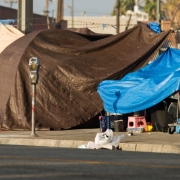San Francisco
This city has been conducting a three-decade experiment in what happens when society stops enforcing bourgeois norms of behavior. It has done so in the name of compassion for the homeless. The result: Street squalor and misery have increased, while government expenditures have ballooned. Yet the principles guiding city policy remain inviolate: Homelessness is a housing problem, it is involuntary, and it persists because of inadequate public spending. These propositions are readily disproved by talking to people living on the streets.
“Everyone’s on drugs here . . . and stealing,” an ex-convict named Shaku explains from an encampment of tents, trash and bicycles across from Glide Memorial Church in the heart of the Tenderloin district. A formerly homeless woman living in a city-subsidized hotel, asked if she does drugs, replies: “Is that a trick question?” Jeff, 50, slumps over his coffee cup at 7:30 a.m. A half-eaten muffin sits next to him on a filthy blanket. “I use drugs, alcohol, all of it,” he tells me, his eyes closed. “The whole Tenderloin is for drugs.”
The city sends the message relentlessly that drug use is not only acceptable but expected. The Health Department distributes 4.5 million syringes a year, along with alcohol swabs, vitamin C to dissolve heroin and crack, and instructions on how to tie one’s arm for a hit. Officials have installed 17 needle-disposal boxes and kiosks throughout the city, signaling to children that drug use is a normal part of adult life.
Only 60% of the city’s free needles are returned; the rest end up on the sidewalks or in the sewers. Users dig for veins in plain view. At the corner of Hyde Street and Golden Gate Avenue, steps away from the UC Hastings College of the Law, I was easily able to purchase a 2-gram pellet of fentanyl for $16, a new-customer discount.
Public drug use has grown worse since the approval in 2014 of Proposition 47, the state ballot initiative that downgraded a host of drug and property crimes to misdemeanors. Local prosecutors and judges, already worried about contributing to “mass incarceration,” are loath to initiate misdemeanor drug cases. San Francisco police officers complain that even dealers get neither jail time nor probation. Drug courts have closed in some California cities, the Washington Post reports, because police have lost the threat of prison time to induce addicted dealers to begin treatment. The number of clients in San Francisco drug court dropped to 185 in 2018 from 296 in 2014, a decline of more than 37%.
The city also enables the entire homeless lifestyle. Outreach workers hand out beef jerky, crackers and other snacks. The city’s biannual homeless survey claims that “food insecurity” is a pressing problem, but the homeless don’t act like food-deprived people. Waste litters the sidewalks and gutters. A typical deposit outside a Market Street office building includes an unopened 1-pound bag of walnuts, a box of uneaten pastries, an empty brandy bottle, a huge black lace bra, a dirty yellow teddy bear, a high-heeled red suede boot and a brown suede jacket.
Free services and food—along with maximal tolerance for antisocial behavior—act as magnets. “San Francisco is the place to go if you live on the streets,” Jeff says. “There are more resources—showers, yeah, and housing.” A man standing outside the city’s latest shelter design, known as a Navigation Center, says that he was offered housing four times but always turned it down. Navigation Centers are designed to be maximally accommodating. Residents come and go as they please, order meals at any time of the day, and bring their pets, partners and possessions (known in shelter parlance as “the three Ps”).
Elevating the rights of the homeless over those of the working public has cost taxpayers billions, with nothing to show for it. The “unsheltered” count continues to rise—up 17%, to 8,011, in 2019 from 2017—and San Francisco continues to wonder why. Is it lack of city-created affordable housing, as advocates and politicians maintain? No other American city has built as many units of affordable housing per capita, according to the Bay Area Council Economic Institute. From 2004-14, the city spent $2 billion on nearly 3,000 new units of permanent supportive housing, which comes with drug counseling and social workers. More have been constructed since, and thousands of shelter beds and apartment units are in the works.
No one has a right to live in the most expensive real-estate market in the country, certainly not on the public’s dime. It isn’t clear why any city is morally obligated to provide housing to someone who starts living on its streets. But assuming such an obligation, the money that San Francisco spends trying to house the homeless locally could go much further outside its boundaries; the millions saved could go to mental-health and addiction services.
Clean and sober campuses, serving an entire region, could be built on abandoned or undeveloped land in industrial zones and rural areas. Cities and counties should pool resources for these facilities, since the vagrancy problem is fluid—people move from one place to another. The bare-bones campuses must be immaculately maintained, safe and disciplined, so residents learn habits of self-control. Everyone should work.
The stories the homeless tell about their lives reveal that something far more complex than a housing shortage is at work. The tales veer from one confused and improbable situation to the next, against a backdrop of drug use, petty crime and chaotic child rearing. There are few policy levers to change this crisis of meaning in American culture. What is certain is that the continuing crusade to normalize drug use, along with the absence of any public encouragement of temperance, will further handicap this unmoored population.
Carving out a zone of immunity from the law and bourgeois norms for a perceived victim class destroys the quality of life in a city. As important, that immunity consigns its alleged beneficiaries to lives of self-abasement and marginality. Tolerating street vagrancy is a choice that cities make. For the public good, in San Francisco and elsewhere, that choice should be unmade.
This article first appeared at wsj.com. Ms. Mac Donald is a fellow at the Manhattan Institute and a contributing editor of City Journal, from which this essay was adapted.










